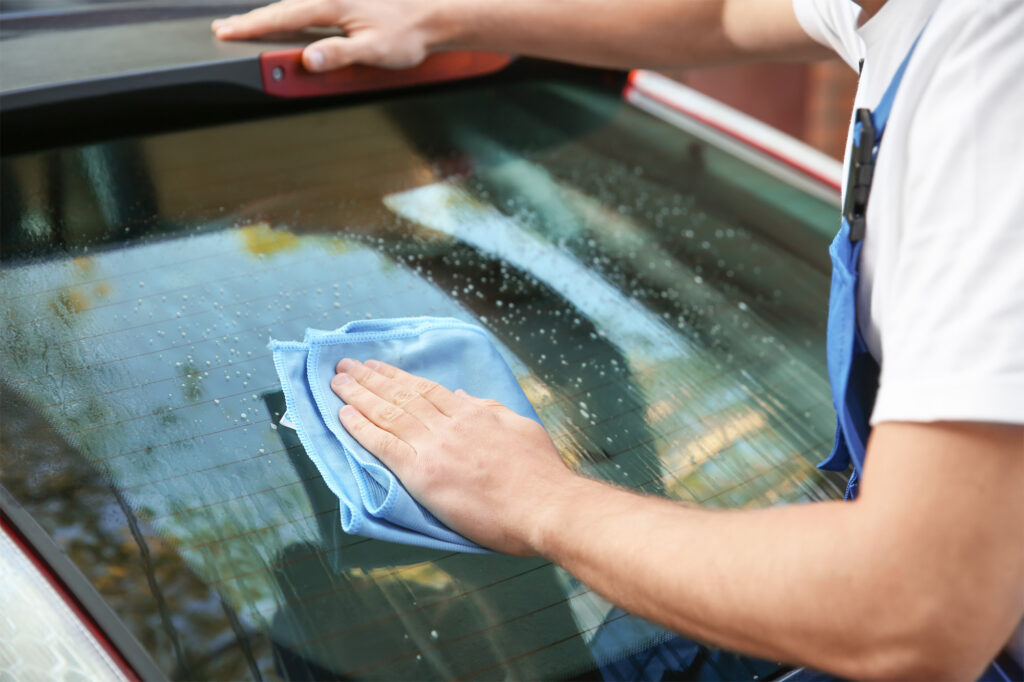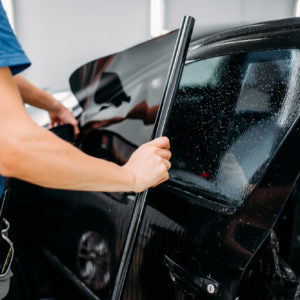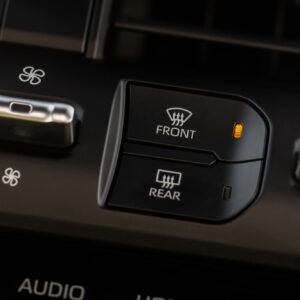If you want to clean tinted windows safely and effectively, be sure to:
- Avoid using glass cleaners that contain ammonia
- Wipe the windows with a microfiber cloth
- Give your new window tints at least a week to cure before cleaning
These are only the essentials, and the dos and don’ts might vary depending on the type of window tint.
How Do Window Tints Work?
Aftermarket car window tints are usually made of polyethylene terephthalate (PET), which is known for its clarity and strength. The PET film is created with metals or dyes, which either reject or absorb heat and ultraviolet (UV) rays respectively.
Cleaning tinted windows the same way you’d clean a normal car window could damage their tint. For example, using ammonia causes the tints to peel and blister.
Knowing which cleaning methods to use is important in keeping your window tints in good condition.
How to Clean Your Tinted Windows Without Using Products
If you’re worried about using commercial products to clean your windows, you could always opt for a more natural method. Instead of risking using harmful chemicals, you can use water and a microfiber cloth to safely clean windows.

What You Need
- Microfiber cloth
- Water
- Spray bottle
What to Do
- Fill your spray bottle with water.
- Roll up the window of your car.
- Lightly spray the window with water.
- Wipe the window with your microfiber cloth until all the dirt is gone.
- Roll the window down slightly.
- Clean the top edge of the glass that goes into the window track.
- Repeat the process with the interior windows.
How to Clean Your Tinted Windows Using Glass Cleaners
If you want to use a glass cleaner for tinted windows, be sure to pick a product that doesn’t contain ammonia. Mixing ammonia with tinted windows could cause the film to peel and degrade.
What You Need
- Window cleaner for tinted windows
- Lint-free cloth
What to Do
- Enter your vehicle and roll up the window of your car.
- Spray the cleaner on your tinted window.
- Wipe the window with a lint-free cloth before the glass cleaner dries.
- Wipe in vertical motions followed by horizontal motions.
- Repeat until all the dirt and streaks in your car’s interior windows are clean.
How to Clean Extremely Dirty Tinted Windows
For those of you whose windows are too dirty to clean with a microfiber cloth or a spray bottle, it might be time to use soap and water. They’ll loosen the grime and dirt, making them easier to remove.
What You Need
- Bucket
- Water
- Dishwashing soap
- Microfiber cloth
- Soft sponge
What to Do
- Fill your bucket with a gallon of warm water.
- Mix in a teaspoon of dishwashing soap.
- Let your soft sponge soak in the bucket of soapy water.
- Wring your sponge until it stops dripping.
- Clean your car windows from the outside with the sponge.
- Occasionally soak and wring your sponge to get rid of dirt.
- Wipe the windows with a microfiber cloth.
- Repeat the process until all the car windows are dirt-free.
- Clean the tinted windows of your car again naturally or with a glass cleaner.
How to Clean Different Types of Tinted Windows
There’s a lot more to cleaning tinted car windows than meets the eye. Because of this, it’s important to stay in the know — especially since there are many different kinds of window tints. Here are some tips for keeping various types of tinted windows squeaky clean.

Ceramic Tint
Ceramic tints are effective enough at reflecting heat that they can block 99% of UV rays. These tints are unique in that they have no dyes or metal particles, meaning they won’t fade over time.
Cleaning ceramic tints is easy. Because the material is protective and durable, you can use soap and water. Most commercial cleaners work exceptionally well when it comes to cleaning ceramic-tinted windows.
Dyed Film
Dyed window tinting is accomplished by coating the interior windows of a car with many layers of dyed PET film. You can adjust how dark you want your car interior to be depending on how much film you decide to use.
Because dyed window tints are made of several layers of PET, be sure to use tint-safe window cleaners to avoid peeling or damaging the film.
Carbon Tint
Unlike dyed window tints, carbon-tinted windows are made up of carbon fiber particles. They last longer because they don’t fade as quickly as dyed film layers. Carbon-tinted windows also have a unique matte look.
Because carbon tints are durable, they don’t require a lot of cleaning or maintenance. If your carbon-tinted window gets dirty, you can clean it easily with a damp microfiber cloth.
Metalized Window Tint
Containing metal particles, metalized window tints are effective in keeping the sun out of your eyes when you drive. Metalized window tints differ from dyed film in how they reflect sunlight instead of absorbing it. They’re also shinier than most window tints and are significantly more shatterproof.
Metalized carbon tints are best cleaned with spray solutions and microfiber cloths, though soap and water work just as well.
Hybrid Window Tint
Last but not least, hybrid window tints combine the best traits of dyed tints and metalized tints. These tints use both dye and metal to protect your car from harmful UV rays.
Because hybrid tints are made of both metal particles and dyes, you can use the same cleaning methods that you’d use for metalized tints and dyed film.
Dos and Dont’s of Cleaning Tinted Windows
Regardless of the type of window tint your car has, these essential dos and don’ts apply:
Window Cleaning Do’s
- Do clean your tinted windows with squeegees or soft cloth.
- Do give your tinted windows a week to cure before cleaning.
- Do use the cleaning products recommended by the installer of your tinted windows.
Window Cleaning Don’ts
- Don’t scrub your windows with steel wool, shammy cloths, or other sharp materials.
- Don’t clean your tinted windows immediately after having the film installed.
- Don’t use strong chemicals like ammonia to clean tinted windows.
Any information provided on this Website is for informational purposes only and is not intended to replace consultation with a professional mechanic. The accuracy and timeliness of the information may change from the time of publication.
































